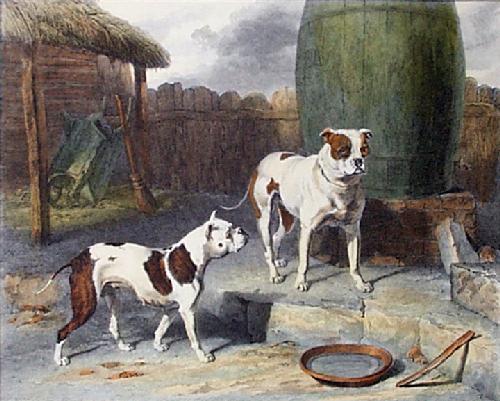
Pop quiz to Bulldog newbies: Do you know who “Rosa” and “Crib” are?
They were considered by many to be the Adam and Eve of the breed, the foundation pair from which most Bulldog bloodlines sprang, and the pair whose type was considered correct enough to be incorporated into the English breed standard, in particular, “Rosa’s.”
In Crib and Rosa, an 1817 painting by Samuel Raven (though Christie’s attributes the painting to Abraham Cooper, a mentor of Raven’s). Rosa’s outline was regarded as perfection in the shape, make, and size of the ideal type of Bulldog, and according to some accounts, “Crib,” a brindle-and-white dog, was considered to be ”the best ever” in his day. Both dogs had deep chests, admirable muscle tone, and low tail sets. They may be very different from our Bulldogs today, but we think it’s important to see visual representations of our breeds in their early days.
Certainly, a roach back may strike some of us in different breeds as undesirable, but it’s always important to refer to the breed standard, and not to one’s general view of soundness. In the Bulldog standard, it writes that, “There should be a slight fall in the back, close behind the shoulders (its lowest part), whence the spine should rise to the loins (the top of which should be higher than the top of the shoulders), thence curving again more suddenly to the tail, forming an arch (a very distinctive feature of the breed), termed “roach back” or, more correctly, “wheel-back.”
Through an engraving by John Scott, this painting became the best-known and most reproduced painting of dogs from that period, and gives today’s fancier an insight into an image of the extinct Old English Bulldog.
Image” by w:User:SirIsaacBrock – http://en.wikipedia.org/wiki/Image:CribandRosa1811.jpg, Public Domain, https://commons.wikimedia.org/w/index.php?curid=3727763
